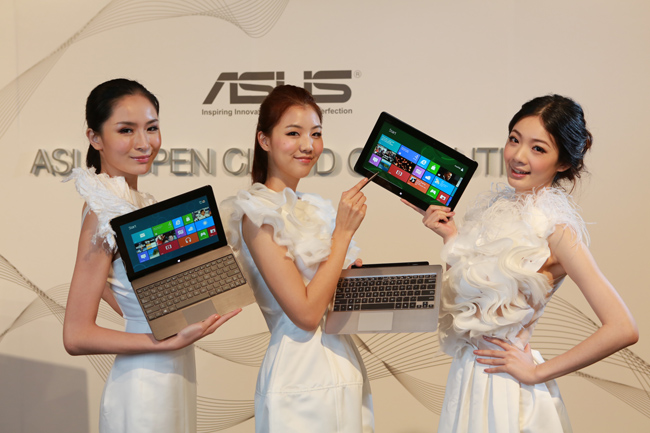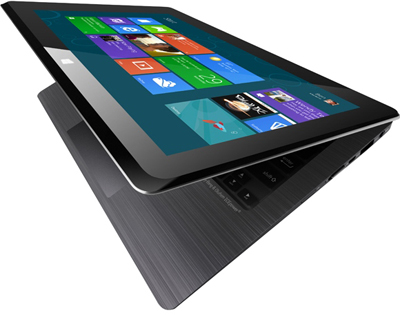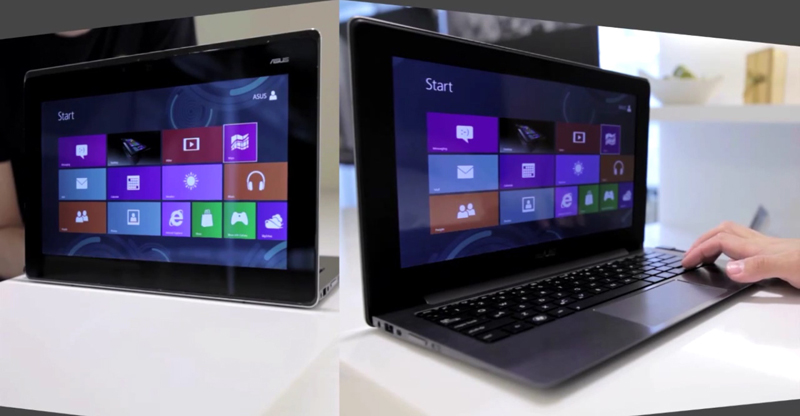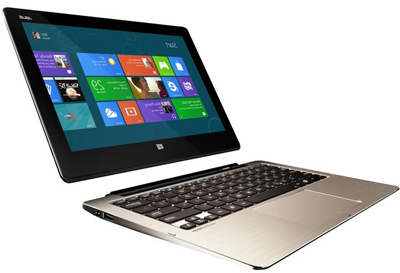New Transformation: Ultrabooks TAICHI and Transformer Book

At Computex 2012, ASUS came to amaze with new hybrid devices. At the exhibition held in Taiwan, two conceptual products of the "cloud era" category of "ultrabook" were presented : TAICHI and Transformer Book . If earlier ASUS tablets were diligently disguised as laptops (netbooks), now it is time for laptops (or, more precisely, ultrabooks) to transform into tablets.
')

ASUS TAICHI is an ultra-portable notebook with a diagonal of 11.6 or 13.3 inches, the distinguishing feature of which is the presence of two IPS-displays with a resolution of 1920 x 1080. The external display is equipped with a touch interface that allows you to use TAICHI either as an ultrabook or as a tablet computer. Both screens are served by the same hardware filling, however they can work both completely independently of each other and synchronously - in this case, the external screen is synchronized with the screen on the inner surface, allowing you to share a picture with others.

With the lid open, TAICHI looks like any other ultra-portable laptop running Windows 8. However, as soon as the lid closes, it instantly turns into a “tablet” with a multi-touch screen and stylus support. Accordingly, in the “tablet” mode, management is carried out through the Windows 8 Metro interface. Did Microsoft assume that their “dual” system could be used so literally?
In Taipei showed an engineering sample, therefore not all technical characteristics can tell. But the following is known for sure: the device works on a third-generation Intel Core processor, has 4 GB of DDR3 memory and an SSD drive. In the presence of a dual-band module Wi-Fi 802.11n, Ethernet, Bluetooth, two USB 3.0 ports, micro HDMI and Mini DisplayPort, audio jack, volume rocker, and the screen auto-rotate off key.

ASUS TAICHI has two cameras (each has its own screen) and a full-size backlit keyboard. B & O ICEpower and ASUS SonicMaster are responsible for the sound quality. Despite all of the above, the device is as light and thin as ASUS ZENBOOK.
ASUS TAICHI is not a concept, but a device for which ASUS hopes for success. Optimism, oddly enough, inspires the tablet market - yet no device has provided such flexibility of work. We have seen many attempts to cross “already with a hedgehog”, but it seems to be easier now — you close the screen and use the tablet if you just want to surf or watch a video.
TAICHI is heavier than a conventional tablet and will cost more, but in addition to high performance it provides a new approach to managing a gadget - this is the true “next transformation”. Here, a lot of things are tied to Windows 8, and it will be possible to evaluate all the possibilities of such collaboration only after the official release. Which we will do immediately, as soon as TAICHI is in our hands.

Transformer Book is not so much surprised, but it is also more focused on ordinary users. We continue interspecific crossing! The idea was borrowed from the hybrid computer ASUS Eee Pad Transformer: the ultrabook can instantly transform into a tablet computer - you just need to disconnect its display from the keyboard. All the advantages of this approach have long been known: the user prefers to work at a high-end Windows-based computer, while resting, having fun with a multi-touch interface.
The hardware configuration of the Transformer Book includes the latest Intel Core processor, a discrete NVIDIA video card, a solid-state drive and a hard disk, 4 gigabytes of DDR3 memory and a USB 3.0 interface. The Transformer Book is equipped with two cameras: a front HD camera for video conferencing and a rear 5 megapixel camera for taking photos and videos.

This ultrabook is available in several versions with a touchscreen IPS-display size of 11.6, 13 or 14 inches. The display is separated from the full-size keyboard to be used as a compact tablet computer. After separating the screen, you have a full x86 tablet, and not a low-power ARM device. The design inherited the features of ASUS ZENBOOK and has not changed.
ASUS TAICHI can still be considered exotic, but the Transformer Book is already similar to the look of the future, in which most serious market players are likely to start producing something similar. There is also considerable merit of Microsoft, because Windows 8 is a fusion of a typical Axis and a tablet-like interface, which perfectly suits the symbiosis of a tablet and a laptop. While the price and the exact release date of the new devices are unknown, it is certainly early to draw final conclusions, but do you think that the market is ready to change under the pressure of ultramodern ideas?
Source: https://habr.com/ru/post/145582/
All Articles